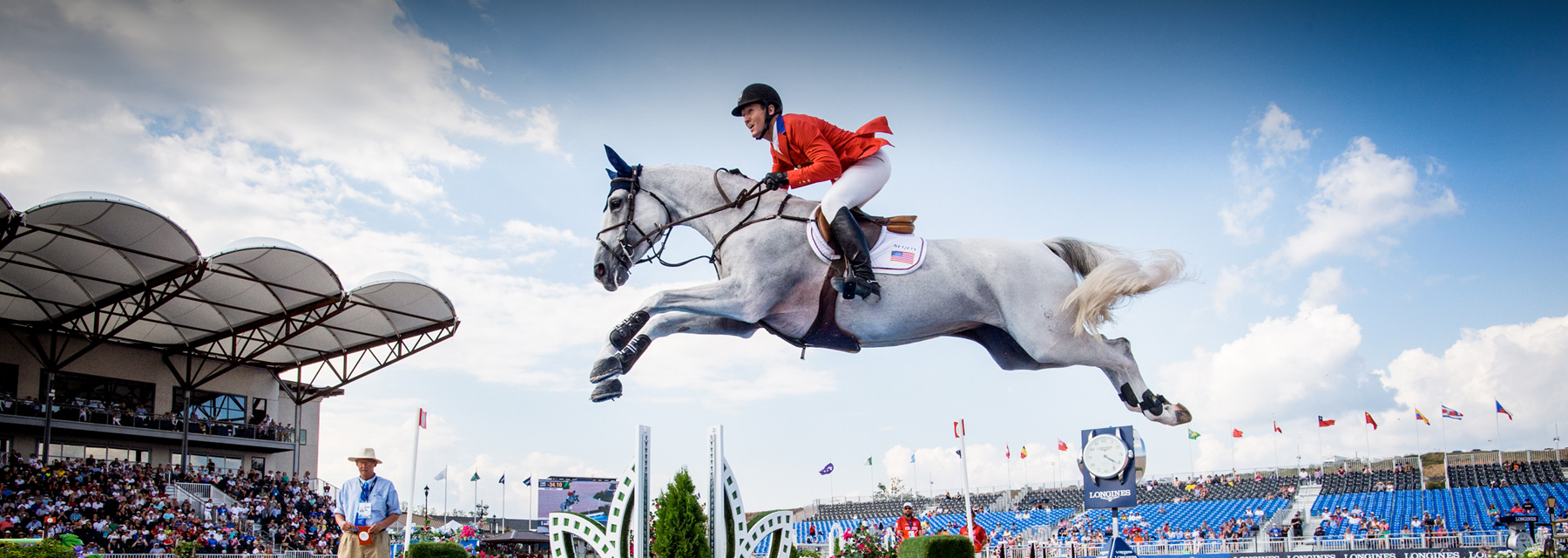The Evolution of How We Treat, Condition
& Feed the Competitive Athlete
The body is a magnificent specimen, capable of high performance and with a keen ability to adapt, heal and answer when called upon. For as long as both horses and humans have existed, our bodies have evolved to meet the ever-expanding demands of our performance. There are obvious differences, of course, but surprisingly, the similarities are abundant and important crossovers have reshaped the world of sports medicine, seeing today’s competitors conditioned and recovered with pinpoint precision using predictive medicine and a whole-body approach to wellness and performance. Veterinary and human care teams are learning from one another, connecting and comparing to spark new research with the goal of building better, stronger and more durable athletes.
A Paradigm Shift
While elite athletes have competed for centuries and high-powered horseflesh has soared to iconic levels in every discipline, the world of high performance has seen perhaps its most important advancements in recent decades. Premier athletes come with innate talent and, oftentimes, a genetic make-up that adds considerably to their potential for success. At the same time, it’s those that maximize that genetic potential and unlock the key to recovery that find the most profound and lasting success. They become the legends in a field of giants.
“The common thread I see most is that athletes don’t understand how to be an athlete,” explains Peter Park, co-creator of Foundation Training, author, 23-time Ironman Triathlete and trainer to numerous professional athletes from the NBA to Major League Baseball and well beyond. “We teach them what it takes to truly recover and to look at it as a business decision and a job to be healthy. They come with the talent,” he says, “but our goal is to keep them on the court, to give them longevity and to maximize their genetic potential. The talent is wasted if you don’t use the right tools to keep it there.” Those tools are what has shifted thinking and rocked the traditional methods of conditioning and recovery. Today’s human athletes and their trainers — or at least the smart ones — have built a team of high-caliber muscle behind them. This is connected, integrative medicine at its very finest, and the team is composed with purpose. Trainers are sought who focus on core strength and longevity. Sports medicine and orthopedic specialists are chosen for their expertise in predictive and preventive medicine and skill in regenerative therapies. Nutritionists are sourced for their ability to impact gene expression, cellular aging, blood glucose and insulin, muscle performance, recovery speed and mental focus with the powers of real, whole foods and targeted supplementation. Sports psychologists are included for their ability to train the most important and complex component of the body, the brain. And finally, the element that ties the team together in a real-time, measurable and actionable way — the data. “We use devices like wearables,” explains Park, “where my clients are connected in real time to a dashboard on my computer. I can see their heart rate, level of exercise, sleep quality, how much REM cycle sleep they’ve had, and I’m able to monitor and measure it. I get a daily recovery score for each of my clients. Thanks to the technology, I can give them a big wake-up call in the form of hard data.”
While human athletes are learning to use the set of tools available to them to impact the length and gravity of their careers, equine athletes are being treated and trained with similar fervor. Veterinarians are learning from their human counterparts while also teaching them in return. Regenerative therapies, for instance, are light-years ahead in the equine realm, while real-time data soars in the human space. Predictive bio-markers are further down the pipeline in veterinary research, while the impact of nutrition is recognized and utilized as a core therapy in human sports medicine. The equine and human arenas of high-performance sport are colliding to propel both species into entirely new territory.
“Prevention has to be the key word in sports medicine.”
— Philippe Benoit, DVM, DACVSMR, Equine Veterinarian & Sports Medicine Specialist
A Whole Body Approach
Once mistaken as simply 'holistic medicine,' the whole-body approach to both equine and human conditioning, recovery, prevention and treatment has become mainstream. Veterinarians, physicians and trainers have recognized that without foundational wellness, treatments fail, goals aren’t met and athletes will never reach their full potential. Today, treating the equine and human athlete begins with building a solid foundation upon which all other therapies are based. Simply put, an unwell competitor isn’t competitive. “It’s not just what we do in the gym with these athletes,” says Park frankly. “It’s their sleep, how we train them to downregulate and how we transform their nutrition. When we see an athlete, we ask what out of those things is missing, and we zero in on each area. I need to know each of these things to do my job well. There’s so much science evolving that tells us these components come together to impact performance. Without a healthy body as a whole, and a healthy mind, there is no healthy athlete — at least not long-term.” Dr. Mark Revenaugh, sport horse veterinarian and founder of the USEF High Performance Sports Medicine Group, which brings together human sports scientists with sport horse veterinarians, agrees, “If the nourishment and overall wellness isn’t where it needs to be it doesn’t matter what you put into the horse’s joint. There are new tools and new options out there at an exponential rate now,” he says. “Our mission is to bring it all together, to connect human medicine with veterinary, get larger conversations going and create positive change.”
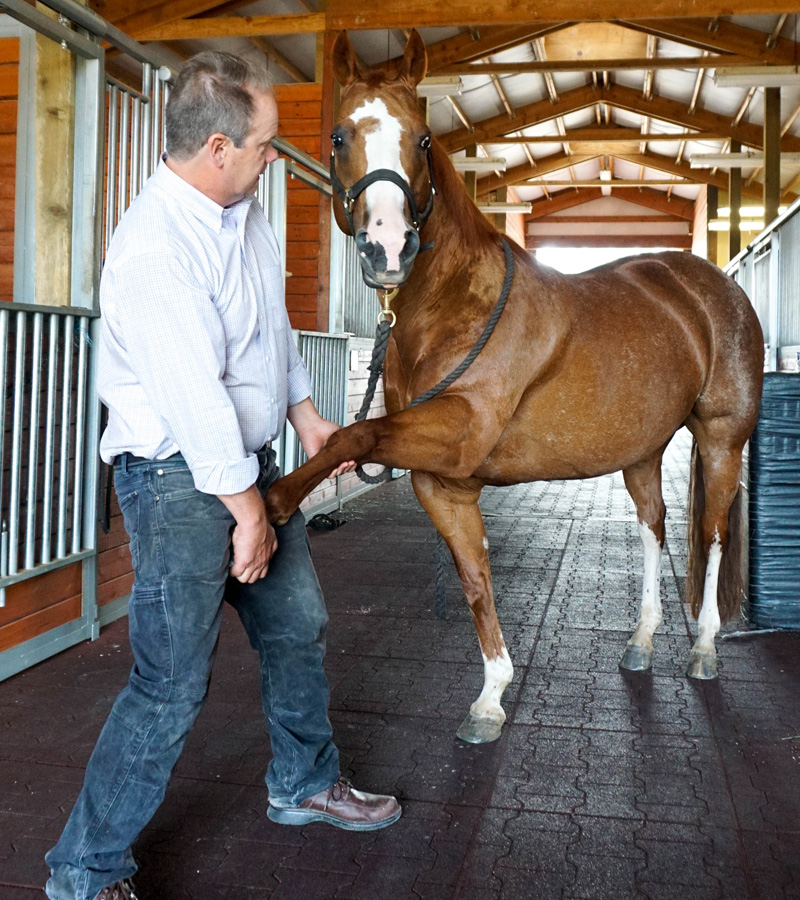
Dr. Revenaugh examining a patient.
PHOTO BY RACHEL BUCHHOLZ, DVM
A Trained Understanding of Disciplines
While there are innumerable similarities between the various disciplines in both human and equine sport, a major advancement in successfully conditioning, treating and recovering athletes has come with specialized understanding of each athlete’s individual discipline. A wide receiver, for instance, will have an entirely different propensity for injury, dietary requirement and muscle conditioning need than that of a pitcher. On the surface this is obvious, but underneath, the sports community was previously ill-equipped to tailor conditioning and recovery programs to truly meet those individualized needs. Today, things are changing. Human physicians and trainers are looking to their equine veterinary counterparts, and vice versa, to propel sport to an entirely new domain. “The horse is made for the race,” explains Dr. Philippe Benoit, equine veterinarian and sports medicine specialist. “His heart and lung capacity are outstanding. His muscle mass, limbs and hoof, and all the action and movement is amazingly relayed by tendons and ligaments. But with time, horses have been selected for different uses. Some of the technical work we ask of them in dressage, for instance, is not as natural as cantering and racing. I see mostly high-level show jumpers, and they are subject to a lot of environmental changes, long transportations and obviously as they show there is a lot of landing and torquing, so we see many ligament injuries. Performance and physical issues are highly related to the discipline, which means that a sport doctor has to know the discipline very well to understand its limits and associated pathologies,” says Dr. Benoit. Dr. Carter Judy sees high performance horses of numerous ages, breeds and disciplines at Alamo Pintado Equine Medical Center, a full-service referral hospital on California’s Central Coast. “What is often overlooked is the adaptive changes that occur to the anatomical structures as a result of forces unique to each breed and athletic discipline in the horse,” he says. “What might be pathology in one breed and discipline may be an adaptive response in another.”
With the athletic demands of each individual human and equine sport being innately similar yet wildly different, it’s crucial for care teams to understand the nuances of their sport to help optimize performance, prevent injury, recover strategically and avoid re-injury. Peter Park lives these challenges every day with clients competing in an expansive array of sports. “I can watch someone move and see if they’re shifting to one side or pick up on the red flags of asymmetry,” he says. “You see a lot of that with basketball players, as an example. They may look great on the court, but they’re a mess in subtle places and they’re going to get hurt. Golfers and tennis players are another example; they’re always moving the wrong side and you’re going to see a lot of bad asymmetries that contribute to problems as they get older. The same goes for people who sit in front of a computer for most of their day with their neck and shoulders rounded forward, it all has consequences unless you work on it.”
Much like human trainers and sports physicians, equine veterinarians confront the challenges of their patients experiencing rigorous competition schedules, new environments, long travel and the stress that goes with staying competitive at the highest level. “The horse is a very giving animal,” says Dr. Timothy Ober, veterinarian for the United States Show Jumping Team. “It amazes me what they will do for us. They will try their best in most circumstances and offer a lot of latitude even when their conditions are not optimal. They’re adaptable and very effective at compensation from a physical standpoint. This is why they rarely have just one problem that they are coping with when they are challenged in their job,” he explains, highlighting that equine athletes, much like human competitors, deal with issues below the surface that go far beyond the obvious joint or muscle concerns typically associated with athletes. It’s a testament to the whole-body approach to training, nutrition and medicine that has brought to light a new class of athletes and the teams that keep them in the game. “Stomach ulcers or colon ulcers are problems that we need to constantly screen for. Those potential issues are always on our mind with performance horses, and we are always looking for subtle cues that suggest the GI tract is out of balance. Most vets working on performance horses obviously also spend a lot of time trying to protect joints. That can be with nutrition, with direct injection of the joints, and by keeping the whole body in the best balance possible. This includes keeping the axial skeleton — the neck and back — mobile and functioning well. Optimal balance throughout the entire body typically involves chiropractic care and requires a certain level of fitness that is not always easy to achieve.” Each component comes together to create the competitor, and it’s those athletes, doctors and trainers that take this to heart who are seeing exponential improvements.
“Human experts are eager to talk to veterinarians because we’re speaking the same language about the same problems, but we’re coming at it from different angles.”
— Mark Revenaugh, DVM, Head of the USEF High Performance Sports Medicine Group
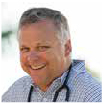
Tim Ober
DVM
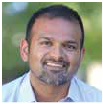
Rahul Desai
MD

Philippe Benoit
DVM, DACVSMR

Carter Judy
DVM, DACVS

Mark Revenaugh
DVM
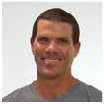
Peter Park
Athletic Trainer, Author,
23-Time Ironman Triathlete
The Importance of Prevention
At the annual meeting of Dr. Mark Revenaugh’s USEF High Performance Sports Medicine Group, some of the brightest minds in both equine and human high-performance medicine have come together since the group’s founding in 2013 with the purpose of sharing ideas, spurring new research and discovering how successful strategies and therapies can cross species and change the lives of athletes, both horse and human. It’s an open format where various experts in athletic performance and recovery can collaborate and build the necessary infrastructure to centralize data and bring a broad topic into greater focus for forward momentum and real answers. Dr. Revenaugh remembers an awakening of sorts that he experienced at the group’s recent gathering, “One of our speakers is with the athletic department for one of the big NBA teams, and I was excited to hear how they were going to treat Achilles tendons or sore knees. His whole talk was about prevention of injury — early identification of a problem and prevention of injury,” remembers Dr. Revenaugh. “I kept raising my hand in the back of the room asking 'what do you do for a sore knee?' He kept responding, 'identify it before it becomes a problem.' He said this over and over again and at the end of the lecture I felt like I got gypped out of a lecture. With time, it sunk in that they actually can do it, they actually can see it coming and prevent it. It’s game changing. I don’t think we’re there yet in equine medicine, but we’re approaching a time when that mindset will become an achievable end. It’s pretty exciting, and it shifts the whole conversation. Traditionally, the veterinary conversation has been 'okay the horse is injured' — that is your starting point. Not anymore.”
Veterinarians and physicians alike are seeing research focused on predictive bio-markers that have the capacity to judge and athlete’s propensity for injury, predict its occurrence and intervene before that injury is allowed to happen. It may sound otherworldly, but it’s in the here and now. Researchers are also furthering the reach of genetics as a tool for determining risk of disease and injury, showing that an athlete’s own genetic make-up can act as a blueprint for their training and care. While some of the more advanced predictive tools are in various stages of research, the ability to prevent disease and injury is very real and happening today. As with most good things, profound results are being achieved by starting in the simplest of places; connected care.
Technology has eased communication and the world of competitive sports is seeing its most successful athletes standing in front of a care team that is intimately connected with one another. Trainers and physicians share data, nutritionists are tapped in completely, chiropractors are communicating directly with an athlete’s trainer and medical team, and this holds true for both horse and human. From a veterinary perspective, Dr. Benoit believes, “Prevention has to be the key word in sports medicine, and it starts by going through a longitudinal follow-up, as done for human beings.” This includes very regular check-ups, sometimes when no one thinks they are necessary. It’s a new way of thinking for owners, riders and grooms, and requires the practitioner to regularly review and re-evaluate horses, even sound horses. “We’re listening to every slight detail that could become an issue,” says Dr. Benoit. “This follow up has a cost, but surprisingly in the long run, it may enable us to avoid more aggressive treatments. For one of my clients with whom I have been working for 6 years now, we have reduced joint injections by nearly ninety percent. The key is I see the horses, one by one, in normal training, jumping, competing and normal veterinary evaluations. The riders and the staff inform me about any suspicious findings, and that teamwork is successful because of thorough communication that includes the farriers, physiotherapists, body workers and nutritionist,” says Benoit.
Dr. Ober takes a virtually identical approach and is equally challenged with the care of horses traveling internationally with multiple caregivers depending on where they happen to be in the world. “Over the years, and especially when working on horses who are truly challenged by their profession, it has become much more important to prevent injury and to prevent wear and tear as much as possible. We rely on regular examinations, which allow us a more intimate familiarity with the horse, and we hope to pick up on small trends and address them early on. A healthy topline, good muscle function, proper shoeing and regular chiropractic care help us try to leave the horse with a minimal level of compensation or loading to cope with during performance.” To Dr. Ober, keeping a horse in the game and off the sidelines due to injury has an additional and very crucial element. “Fitness. Fitness. Fitness,” he says. “Having a high-level jumper fit to do the job and mitigate risk of injury is harder than most people think. We focus treatment a lot more on the topline now than when I started practicing. We perceive that we actually help protect the joints of the distal limbs by keeping the topline supple and toned, and the horse well-balanced as a result. This of course requires a proper training program. There is no doubt that there are a few specific riders whose programs excel at developing topline suppleness and strength, and their horses are more sound as a result.” This equates to maintaining optimum core strength in human athletes, a practice that has only become fully appreciated in recent decades.
By using a whole-body approach to building, training, feeding, supplementing and maintaining elite athletes, these competitors are staying in the game for significantly longer. Today it’s not simply sports medicine, but rather, integrative care that is able to create a new breed of competitor. To realize that success, however, is to realize the process starts early. The approach is preventive and proactive rather reactive. Dr. Revenaugh puts it into perspective to his clients on the daily. “The amount of time and money invested over ten years in getting these animals to Grand Prix level is astounding,” he says earnestly. “Once the athlete is at an elite level, the key is staying there. If you can lengthen the time where a horse can compete at that top level it’s extremely valuable. The problem is, you can’t go backward, and that means that there are things you need to be thinking of along the way. It’s a mindset, and it starts early on in a horse’s career. Some of the horses that are really talented, it is really tempting to overdo it with them because it’s easy for the horse, but overdoing it when they’re young has consequences down the road.”

PHOTO BY ELIZABETH HAY PHOTOGRAPHY
Definitive Diagnostics
While preventing injury is far more effective than treating injury, the simple reality is that injuries do occur. When that happens, there are key steps that improve the odds of athletes returning to their previous level of performance with fully regained strength. Advanced diagnostics have allowed physicians and veterinarians to pinpoint injuries with exactness. Obtaining a definitive diagnosis, and doing it quickly, improves outcomes for both human and equine patients. Minimizing the time between diagnosis and treatment is imperative.
Advanced imaging has taken diagnostics to an entirely new level in recent years, with Magnetic Resonance Imaging (MRI) and ultrasound being two heavily relied-upon tools. In the human orthopedic space Dr. Rahul Desai brings a unique perspective to the game. A trained radiologist and orthopedic specialist, he is able to not only perform the imaging but also read it immediately and translate its results directly into treatments. “MRI has become my mainstay,” says Dr. Desai, “but also the use of real-time ultrasound has been one of the most significant changes in my practice; it’s paramount. I use it in every patient almost without fail, from a peripheral joint to even occasionally on the spine. We call it ‘focal point of care ultrasound, or FOCUS.’ That represents probably the biggest delta in the last ten years for diagnostics intervention. The nice thing is that you can do it in the office, right then and there. You’re talking to the patient, you’re evaluating them, you can stretch the tissues and look dynamically at what’s happening while seeing for yourself if the joint is unstable, if the tendon is dislocating or subluxing, or what’s happening with this tissue. You can compare it with the opposite side to see if what’s going on is normal or if the patient is asymmetric on one side.” While Dr. Desai relies on ultrasound daily, he stands by MRI as the gold standard in imaging. “MRI is under-utilized or improperly utilized in a lot of human settings because the radiologist is removed from the patient. There’s a disconnect — the clinician sees the patient, but the radiologist is the expert reading the imaging without the context of seeing the patient. This causes things to be missed even though they’re right there. Radiologists — at least in human medicine — are oftentimes trained to look for surgical issues, not opportunities for regenerative treatment. They’ll look at things and think ‘we really can’t treat that or that’s just arthritis and not something that can be fixed.’ In reality, those things may be the most significant pain generators or issues for the athlete or the patient.” His point drives home the need for connected care between all parties supporting an athlete, or for that matter, any patient in general. Veterinarians deal with the complicating factor of practicing ambulatory medicine in many cases, meaning that they are seeing the patient in its own environment, often performing everything from routine wellness care to lameness exams and small procedures in the field and out of a clinical setting. A small number of referral hospitals, however, have the capability to perform start-to-finish medicine more similar to what Dr. Desai describes. Alamo Pintado Equine is one such facility, where Dr. Judy — an authority on equine MRI — is able to perform the actual imaging, interpret the results immediately and consult directly with the surgery team face-to-face. A surgeon himself, he recognizes the advantages of this team-based approach. “We try to provide comprehensive care. We want our patients to be able to benefit from the imaging and treatment in the most expeditious and accurate way possible,” he says in reference to shortening the period between diagnosis and treatment when all tools are available in one location. With that said, Dr. Judy believes wholeheartedly that thorough diagnostics and accurate interpretation of the imaging is perhaps the most important part of the process, “I would rather be right than fast,” he says. “We had a case today where we did an MRI and found an incomplete fracture. As I was interpreting the results during the MRI, my colleague who would have been performing the surgery was right there. We made the decision that the horse, in fact, did not require surgical intervention. Rest, rehabilitation and nutritional support will provide the best outcome for that case. In other cases, a different decision may have been made based on the imaging and interpretation, but the imaging gives us the support that we’re making the right decision in terms of treatment.”
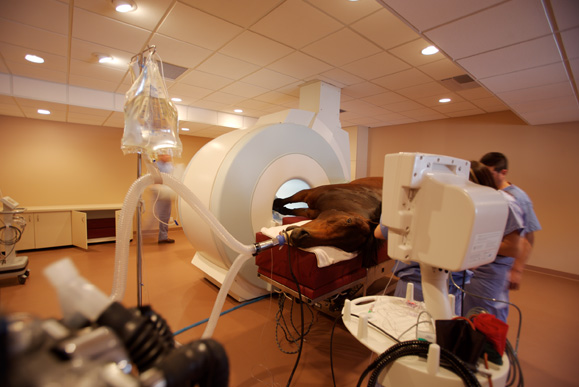
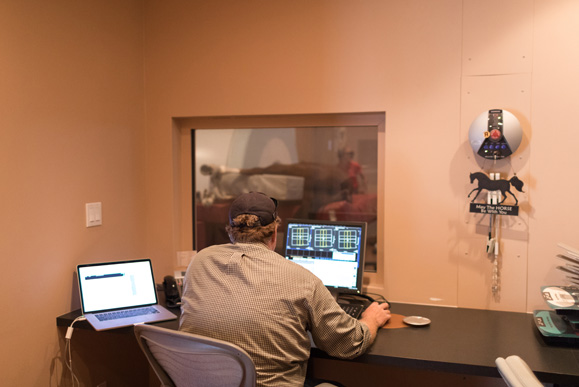
Dr. Carter Judy interpreting MRI results at Alamo Pintado Equine Medical Center.
COURTESY PHOTOS
The Rise of Regenerative Medicine
Until the mid 1990s, a horse with a torn suspensory ligament had just a twenty percent chance of returning to its previous level of performance, on average. Said plainly, a great number of joint and soft tissue injuries were career-ending for even premier athletes with the best veterinarians and rehabilitation programs available. When equine stem cell therapy was revolutionized, that number jumped to upwards of eighty percent of horses returning to their previous level of work. The results astounded the equine and human medical communities. Human physicians looked to equine practitioners and researchers to learn about the vast possibilities of treatments like stem cell therapy and PRP (Platelet Rich Plasma). Equine veterinarians were seeing tremendous success with numerous conditions from laminitis to lymphangitis and had even seen Dr. Doug Herthel return full mobility to a previously quadriplegic donkey, using stem cells cultured from a race horse. The potential rocked the boundaries of what was thought possible. For athletes, however, it meant that orthopedic injuries were no longer met with just corticosteroids; there is now a better way and it uses the patient’s own body to heal itself. “There has been a big shift away from corticosteroid use in joints over the years,” says Dr. Ober. “Of course, there is still an important role for these medications, but there are constantly evolving possibilities to treat problems using the body’s own ability to heal,” he says. From a human physician’s perspective, Dr. Desai agrees, “Up until about ten years ago it had been mainly steroid injections to help reduce inflammation. However, about that time — and before that in equine medicine — we realized that a patient’s own concentrated blood product can be delivered into the area and can actually heal. I changed my career path to focus on interventional orthopedics and regenerative medicine.” Since that time, Dr. Desai has become a foremost authority on the use of regenerative medicine in human orthopedics. “Regenerative medicine really changed my paradigm of practice. Before that my practice was unique in that I was a radiologist and was able to examine the patient, talk to them, use the imaging, evaluate the imaging on a different level than a non-radiologist physician, get the diagnosis, treat the patient or deliver medicine. Unfortunately, that medicine was a steroid. The patient would feel better for three to six months but would come back and tell me ‘now it’s worse than it was before.’ The second time I treated them they got ninety percent of the benefits for two months, then I’d treat them again and they got fifty percent of the benefits for a month. Then it would stop working all together and it was a moment of, ‘what now?’ We realized not only were we not helping them but now a year later their arthritis or their tendinopathy has become worse. Unfortunately, it wasn’t just time that was causing that, it was actually the steroid accelerating it. We were frustrated to see that and, having heard about regenerative medicine and PRP, it was time for a change.
Autologous stem cell therapy had already been delivering significant results in equine medicine and discoveries were coming rapidly. Human physicians took cues from veterinarians on how best to use this new treatment method in practice. Although Dr. Desai recognized the potential for regenerative therapies early, “We had what was probably the first patient ever treated in practice with PRP; a twenty-five-year-old who had been in a skiing accident with a partial rotator cuff tear. This was basically non-surgical, no one knew how to touch it and they told him ‘when it completely tears, come back and we’ll do surgery, up until then, do physical therapy and take pain meds.’ That was as good as it got for him. He was pretty dysfunctional so we did PRP and six weeks later he came back completely healed. He said ‘I feel amazing.’ I said ‘ok let me scan it and I looked back on the MRI and it didn’t make sense. The rotator cuff tendon had completely healed. I was in shock. I didn’t expect that. It took another forty patients for me to whole-heartedly believe this was actually working, and that PRP was legitimate. It completely changed the way that I practice medicine. We now had a technology that could actually heal, and that was powerful. Now we could treat them without surgery, they don’t have to be in pain and they don’t have to have the dysfunction or the reliance on narcotics. If they’re an athlete, we can actually get them back to high-level performance.”
While veterinarians have continued to revolutionize regenerative therapies at a considerable rate, human medicine is still discovering the reaches of stem cell therapy and PRP in specific and debilitating orthopedic injuries. Dr. Desai has been on the front lines, moving progress forward for elite athletes facing the possibility of early retirement due to injury. “Some of the best data that we’ve seen in human athletes is for grade I or II tears of the ulnar collateral ligament in the elbow. There’s excellent data out there in Major League Baseball pitchers showing ninety percent plus success rate with PRP injections for partial thickness or very small full thickness tears of the ulnar collateral ligament. That’s a pretty common injury and a pretty invasive surgery, known as Tommy John Surgery.
The patient is off for at least a year with rehab, but they now have pitchers coming back after six to eight weeks. That’s a huge difference. The Anterior Cruciate Ligament (ACL) is another example. ACL tears are prolific in numerous competitive and recreational sports, and had previously left the patient permanently weakened with a high potential for re-injury. “We’re treating partial thickness tears, and even some properly stratified complete tears of the ACL in those non-contact, cutting athletes,” says Dr. Desai. “These are athletes that will cut and turn then tear the ACL in their knee. It’s a pretty devastating injury and can be career ending. There is a significant percentage of athletes that won’t return to that level of performance after this injury. With the right case and circumstances, we have completely healed this injury and the athlete has returned fully to their sport within four to six months. Time will tell if this, more functional, and more physiologic repair, proves to be better in the long term.”
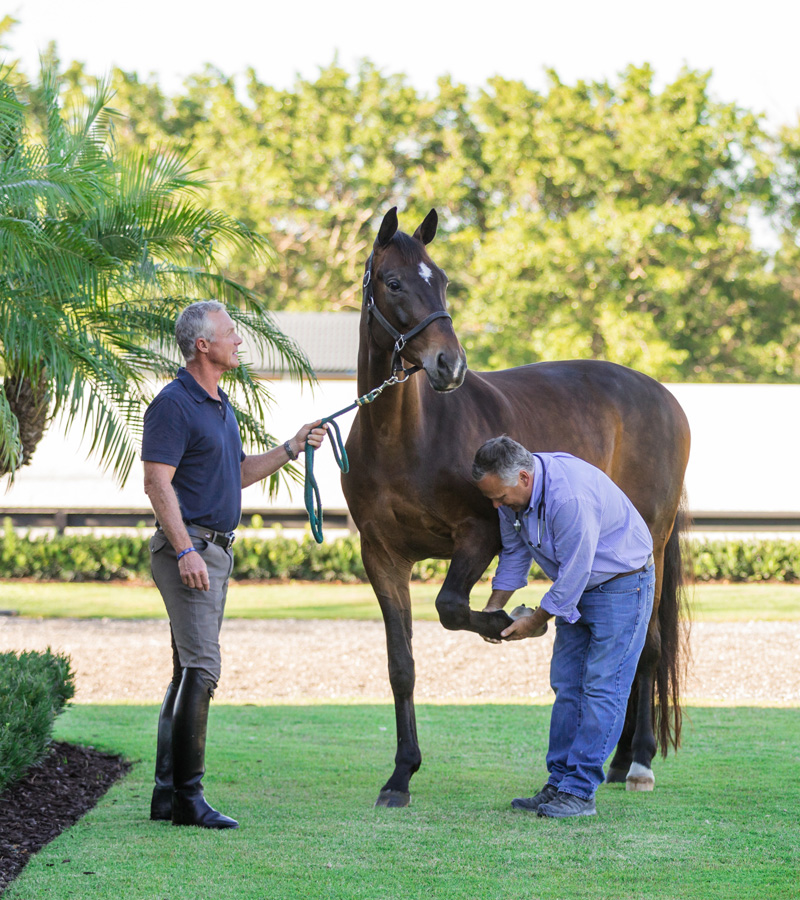
Equine veterinarians were seeing tremendous success with numerous conditions from laminitis to lymphangitis and had even seen Dr. Doug Herthel return full mobility to a previously quadriplegic donkey, using stem cells cultured from a race horse. The potential rocked the boundaries of what was thought possible.
Dr. Tim Ober with client Jan Ebeling.
PHOTO BY ELIZABETH HAY PHOTOGRAPHY
Using Nutrition as a Tool
The use of therapeutic nutrition is now considered a form of regenerative therapy, using potent nutrients to help aid in prevention, act as a complimentary therapy to more clinical approaches and play a significant role in rehabilitation. “Nutrition is without question my first concern when I visit a barn or I am referred to evaluate a horse or a group of horses,” says Dr. Benoit emphatically. “The basic diet is fully evaluated, and forage and water are analyzed and controlled. Specific nutrients are taken into account for each individual condition or issue. We control blood work, muscle condition and fatigue resistance. With a large amount of available products, a company like Platinum Performance® offers us the opportunity to pick the right product for the right horse and then make custom-made nutrition programs. The formulation is paramount. Dr. Doug Herthel, founder of Platinum Performance®, was a visionary and one of the first people I met who believed that we had to push veterinarians to be more involved in nutrition.”
Sport horse veterinarians and human sports medicine physicians, along with trainers and nutritionists have now recognized therapeutic nutrition as a standard of care for both prevention and treatment. “Everything I needed to learn in veterinary school was taught in my second quarter nutrition class. Every disease or problem was mentioned there. And if I knew then what I know now, it would have made the rest of veterinary school a lot easier,” says Dr. Judy with a laugh. “Everything builds off of what we learned in that nutrition class, especially in a performance athlete. It may not fix a broken bone, but it’ll absolutely support the healthy recovery.”
Although the science is vast, the execution can be made simple, with select nutrients having the capacity to help support performance. “Veterinarians are beginning to see the benefits of targeted nutritional supplementation in their patients, and in many cases are driven by owners and trainers to find solutions that provide support for healing and health.” says Dr. Ober. “An example is the way we use vitamin E supplementation to support muscle function. There are several myopathies which present themselves insidiously, and which can be supported by ensuring that the horse has sufficient levels of vitamin E to support optimal muscle function. Sometimes this happens along with a high fat, low starch diet so that the body is encouraged to use the most efficient fuel source for the individual. I add omega 3 fatty acids as well, and I also recommend supplementing with trace minerals, supporting the joints and also the muscles.” With hay being commonly deficient in both omega-3 fatty acids and vitamin E, along with key trace minerals and vitamins, supplementation for whole-body wellness is crucial in all horses, with high-level athletes then having further specific needs met with more targeted nutrients.
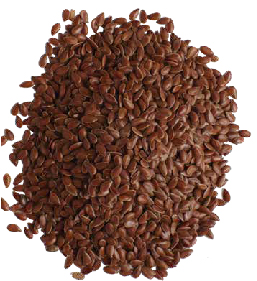
“Nutrition is the foundation of all of these problems and their solutions, especially in a performance athlete. It may not fix a broken bone, but it’ll absolutely support the healthy recovery.”
Carter Judy, DVM, DACVS, Alamo Pintado Equine Medical Center
In the realm of human sports medicine, the role of therapeutic nutrition is significant and well established. Carefully chosen nutrients are used as trusted tools for helping to maximize foundational health and athletic potential. “The good athletes realize the importance of nutrition,” says Peter Park. “For me, this is so important.” Park has made nutrition a mainstay with every client he sees, focusing intently on transforming their body by way of not only physical training, but with their diet. “I tell them, you can’t eat fast food and processed food and expect to have energy; it’s going to happen, you’re going to crumble. And the same goes for the horse. I try to make the athletes think of longevity. When they don’t realize the importance of nutrition their careers usually last an average of about three years. If you don’t maximize that potential, you’re not being very smart,” Park says plainly. A trainer by trade, Park invested himself fully in nutrition more than 20 years ago, recognizing the role it plays in prevention and recovery even then. “Athletes don’t necessarily realize that a good diet can prevent a lot of injuries simply because you’re maintaining normal healthy levels of inflammation. I tell my clients, ‘your health and what you look like is eighty percent diet. If you don’t change your diet we’re not going to reach your goals. You can’t out train a bad diet.’”
Park keeps his philosophy on diet and supplementation simple and approachable but sees transformative results. “I always say ‘cut out sugar and processed foods, then you’re eighty to ninety percent there.’ That includes things like packaged deli meats, and my clients oftentimes don’t realize that. Then, the next step is to personalize their diet further — an endurance runner has to eat more carbs than most people, whereas a power athlete can get away with less carbs. It really is simple, carbs should be based on your output. I’ve always believed in not being fat-phobic and eating healthy fats as well, primarily omega-3 fatty acids. Bottom line, the program has to be sustainable. I eat good fats, moderate protein, a lot of vegetables and not a lot of dairy. I’m a big believer in eating real, unprocessed foods.” A similar approach is echoed by equine sport horse veterinarians, who often recommend basing the diet on high-quality forage with minimal grains and concentrates, then supplementing to fill gaps and for specific performance goals or health concerns. “My philosophy is to have a non-complex, basic diet,” says Dr. Benoit. “The basis is an excellent forage.”
To Dr. Revenaugh, nutrition is a crucial component to the bigger picture of preventing and also treating and recovering the sport horse. “There is no way around it, the more I work with top-level human, athletic advisors who are really in the thick of it — it’s just one of the central pillars of how they get humans to be able to perform and compete.” Along with diet, supplementation plays a significant role, with veterinarians now recognizing it as complimentary to medical therapies and critical in prevention. For high-level equine athletes and their human counterparts, what’s in the supplement is just as important as the results it delivers. “I make sure every company we source from has laboratory analysis with proof of screening for banned substances,” says Dr. Benoit firmly. Formulas that meet this criteria are a standard of practice in human sports medicine and have become so in veterinary medicine as well over the last decade. It’s an ‘every case, every time’ approach that sees sport horse veterinarians and physicians incorporating diet and supplementation recommendations into every patient’s protocol.

The Intersection of Horse and Human
While the differences between elite-level equine and human athletes are many, so are the similarities in how their care teams are working to prevent, treat, heal and keep these competitors in the game with lasting success. Science and technology have opened doors and redefined possibilities, with whole-body foundational wellness acting as the foundation for connected care that includes training, medical treatment, therapeutic nutrition and proactive monitoring to help avoid injury. A primary goal is now to decrease the use of pharmaceuticals, opting instead for regenerative therapies, rehabilitation and targeted nutrients to support athletes returning to health and performance and minimize time on the sidelines.
Information is being shared, conversations have been sparked and veterinarians, physicians and trainers are eager to see greater organization, centralized research and increased momentum for the benefit of their patients — both horse and human. “I’m enthusiastic about us building a structure where we communicate with each other and find answers to real life issues that are facing practitioners with upper level athletes,” says Dr. Revenaugh. “It may be regenerative medicine, how we more scientifically look at conditioning, training and biomechanics, or new options that let us see things differently. That structure will be the key to moving forward in a meaningful way.” Dr. Benoit echoes the enthusiasm for what a more translational approach could mean for all involved. “It’s exciting to see teams of people working on so many topics. There’s a lot of progress happening in imaging, analysis of the microbiome, nutrition, regenerative medicine, interaction between feet and footing, and movement analysis to detect early issues in musculoskeletal conditions.” As human sports medicine continues to propel forward with key physicians and trainers tapped in to their veterinary colleagues, veterinary medicine is focused on maintaining the same rapid development of ideas, therapies and non-pharmaceutical options to create better, healthier athletes with improved durability and longevity. Dr. Ober sums up the current state of veterinary sports medicine precisely. “The challenges of the day are always different, but we always have the same goal of improving the life of the horse. I think that veterinarians by nature are driven to do better for their patients, and there is a great collegiality among veterinarians who work on performance horses, which helps us all get better. I really appreciate that about my colleagues and about this profession. We also have so much more technology that allows us to be ever more specific with our diagnosis, complemented by a huge range of benefits from regenerative medicine and nutrition to support healing, as well as the integration of physical therapies and chiropractics. These tools along with advancement of training programs to prevent injury mean we can do a better job of helping a horse be sound and happy in their work.”
In the quest to do better, treat better and health better, sports medicine practitioners and trainers have discovered some of the greatest advancements of our time, meanwhile creating healthier competitors and challenging the profession to question the status quo, seek alternatives, consider new possibilities and set big goals. The science of sport has hit a new gear and the forward motion has only just begun.

by Jessie Bengoa,
Platinum Performance®
